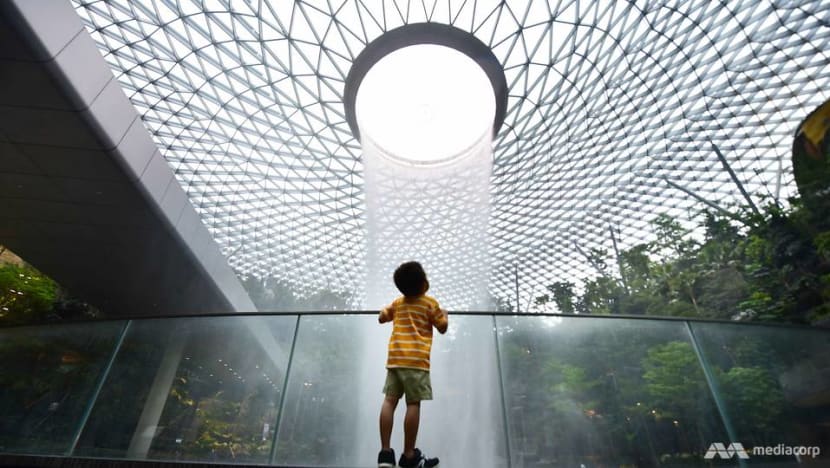Remaking Singapore: After Jewel, 5 other big projects set to raise the game

A boy looking up at the 40-metre high indoor waterfall in Jewel Changi. (Photo: Gaya Chandramohan)
SINGAPORE: In his National Day message on Thursday (Aug 8), Prime Minister Lee Hsien Loong spoke of Jewel Changi Airport as "just one of the many things we are doing to remake our city".
Other projects include Changi Airport Terminal 5, Tuas Megaport, the Jurong Lake District, the redevelopment of Paya Lebar Airbase and the Greater Southern Waterfront.
“All these projects will keep us busy, and create new opportunities for Singaporeans for decades to come,” said Mr Lee.
READ: Government will continue to "invest heavily" in Singaporeans, says PM Lee in National Day message
Here is more information about the projects and how, upon completion, they may benefit Singaporeans.
1. FLYING HIGHER WITH CHANGI AIRPORT TERMINAL 5
Unlike regular terminals, the super-sized T5 could be a game changer for Singapore’s competitiveness as an air hub.
The terminal is being built on 1,000 hectares of land, which is equivalent to the size of Tampines new town or 2.5 Marina Bays. For scale, the rest of the airport occupies 1,350ha of land.
When completed by 2030, the terminal will increase Changi’s annual capacity by 50 million passengers initially and up to 70 million if needed, which means Changi could potentially serve 150 million passengers a year, compared with the current capacity of 82 million.
T5 will also make use of renewable energy and have technologies such as automated check-in kiosks and bag drops.
The project, expected to cost tens of billions, will have a station serving it on the Thomson-East Coast Line (TEL).
READ: Why Singapore needs Changi Airport Terminal 5, to fly higher
2. RULING THE SEAS WITH TUAS MEGA PORT
The future of Singapore’s maritime sector could singularly lie in the Tuas mega port, set to open in phases starting from 2021 and be twice the size of Ang Mo Kio new town.
The port will have the capacity to hold 65 million twenty-foot equivalent unit (TEUs) of cargo – more than the 50 million TEUs the existing terminals can hold annually.
The terminal will also benefit from automation, which is important for customers who want faster service and can help Singapore stay ahead of the game, especially as countries in the region are investing heavily in their port capabilities.
In an interview with CNA Insider, PSA International group CEO Tan Chong Meng said that with innovation, the global port operator imagines a future that will be able to support both Tuas as a port and the Tuas hinterland, so that future manufacturers and commercial, industrial and logistical players can all benefit.
READ: Why Singapore needs Tuas mega port to keep ruling the seas
3. JURONG LAKE DISTRICT THE SECOND CBD
What's the first thing that comes to mind when you think about Jurong?
Jurong Lake District hopes to "change people's mindsets about Jurong", said Mr Keith Tan, chief executive of Singapore Tourism Board, earlier this year.
By 2026, it will have an integrated tourism development with attractions, hotels and other lifestyle offerings.
When the entire 360ha district is completed after 2040, there will be more than 100,000 new jobs and 20,000 homes.
The district has been touted as Singapore's second Central Business District (CBD), with the now-postponed Kuala Lumpur-Singapore High-Speed Rail (HSR) project previously set to have a terminus there.
Despite the hiccup in the HSR project, the impetus and vision for Jurong Lake District still remain, Minister for National Development Lawrence Wong said.
Currently, the district has been divided into two precincts - Jurong Gateway, the commercial hub where redevelopment has already begun; and Lakeside, where the HSR terminus was supposed to be located.
4. MORE SPACES FOR HOMES, PARKS WITH PAYA LEBAR AIRBASE MOVE
More homes, offices, factories and parks – that’s what you can expect when the Paya Lebar Airbase gets relocated to the expanded Tengah Airbase.
The space that will be freed up when the airbase relocates is equivalent to about five Toa Payoh towns, according to the Urban Redevelopment Authority (URA).
URA hopes to make it a “highly liveable and sustainable new town” while retaining its rich aviation heritage.
Mr Lee had previously announced the plans for the air base at the 2013 National Day Rally.
“You look at this area, it is 800 hectares. It is bigger than Ang Mo Kio, it is bigger than Bishan. But (when) it moves out, we will build new homes, new offices, new factories, new parks, new living environments, new communities,” he had said.
5. NEW ADDITION TO THE SKYLINE – THE GREATER SOUTHERN WATERFRONT
The Greater Southern Waterfront will take over the area freed up after the port at Tanjong Pagar relocates to the Tuas mega port.
Its projected start date is in 2030, but there is already much to anticipate. In 2018, authorities announced plans to integrate Sentosa with the southern waterfront and to develop the island of Pulau Brani.
READ: Sentosa Island, Pulau Brani development plans in the works
The waterfront will comprise a verdant island with different types of housing, an island for play and tourist attractions, and a futuristic city that is an extension of the CBD providing access to Singapore’s green pathways.
There may even be an eco-corridor to provide a continuous link connecting Gardens by the Bay to the island-wide green network, including the Rail Corridor and Southern Ridges.












